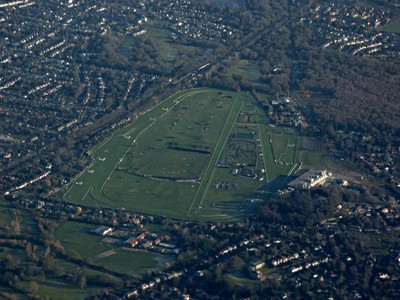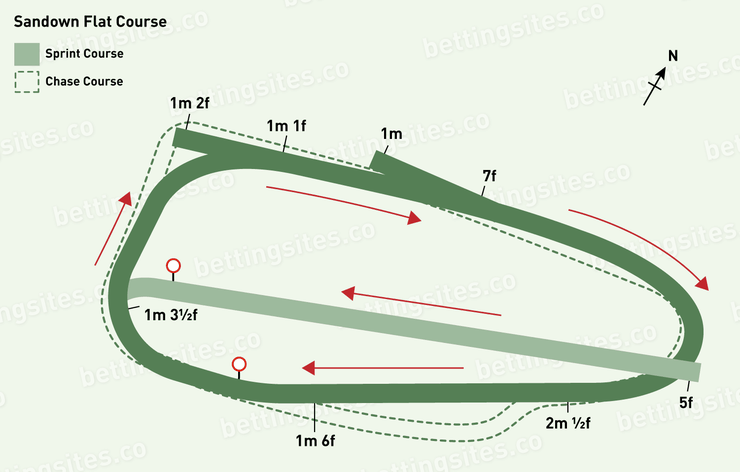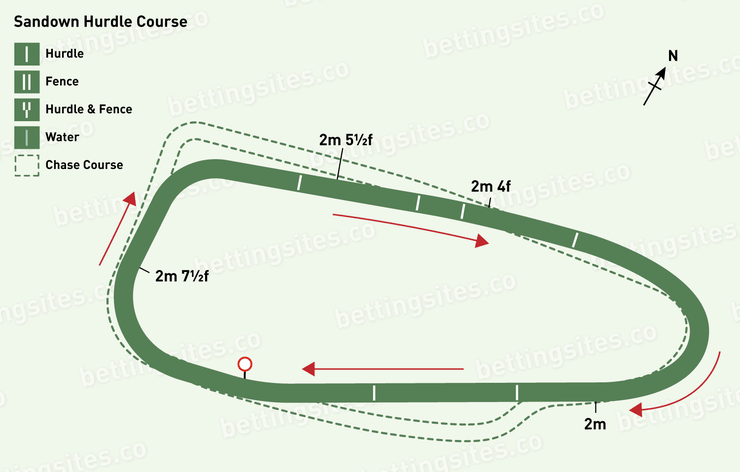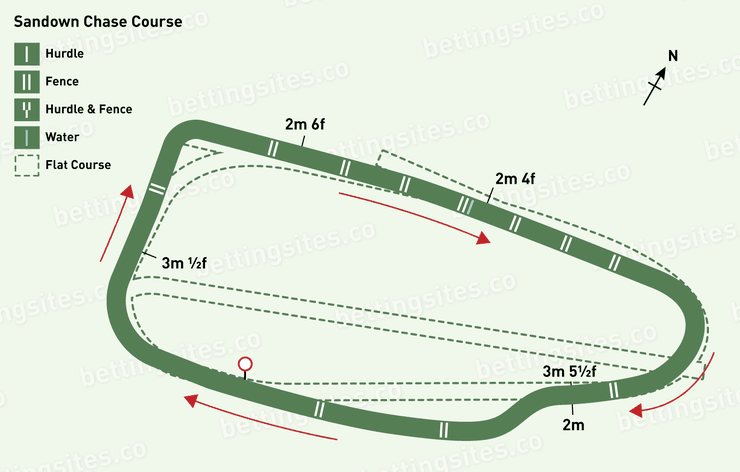
One of the UK’s top dual-purpose courses lies in the outer suburbs of London at the excellent Esher venue of Sandown. Opened back in 1875, the track has risen to feature amongst the top bracket of courses in the UK, and stages top level events both on the flat and over jumps.
Lying only five miles from Kingston upon Thames, Sandown is home to the bet365 Gold Cup, Tingle Creek and Coral Eclipse Stakes, amongst other quality contests. The big mixed meeting in April has also come to take a prominent place in the racing calendar – representing the moment at which the National Hunt season draws to a close, and the flat season begins.
Racecourse Facts
Upcoming Fixtures
| Date | Day | Course | Type | Track |
|---|---|---|---|---|
| 23/05/2024 | Thursday | Sandown Park | Flat | Turf |
| 14/06/2024 | Friday | Sandown Park | Flat | Turf |
| 15/06/2024 | Saturday | Sandown Park | Flat | Turf |
Course Summary

The majority of flat and hurdles races take place on the same track at Sandown, whilst chase events cover much of the same ground, but for the use of an alternative home straight.
The track itself is, broadly speaking, an elongated asymmetrical oval. The first two bends following the winning post being close to right-angular, but the turn from the back straight into the home straight consisting of an almost continuous semi-circle. Flat, downhill, and uphill sections all feature on the course, with the most demanding rise coming throughout the home straight. That stiff finish, combined with the long galloping straights, mean that an ability to see out the trip strongly is a must at this track.
Sandown is also renowned for being one of the best draining tracks in the country, meaning that heavy ground is a real rarity at the Esher venue.
Notable Trends
Sandown is one of the better tracks in the country for supporters of the market leader, particularly in the non-handicap events. Favourites boast a 45% strike rate in such contests on the level, and an even better 51% over jumps.
Fans of trainer trends should look to the big guns when considering a bet at Sandown, with John Gosden and Sir Michael Stoute leading the way on the flat in recent years with close to 20% strike rates, and Messrs Paul Nichols and Nicky Henderson achieving a similarly impressive 21% figure over jumps.
Sandown Flat Course

Sandown’s flat course extends for 1m5f and features a steadily rising run-in of four furlongs, which only really begins to level off inside the final 50 yards or so. The main outer track contains the seven furlong, 1m3f, and 2m starts, with the 1m, 1m2f and 1m6f races beginning from short spurs leading off the main track.
Given its right-handed nature and relatively tight turns, it isn’t too surprising to learn that it is an advantage to be drawn low against the inside rail. This draw factor is particularly important over seven furlongs as the first bend comes up very quickly following the start.
The 2m and 1m6f events are the only flat contests in which the runners pass the winning post twice. After crossing the line for the first time, they are first faced with two fairly sweeping and undulating turns which then take them into the relatively level back straight. From the back straight the field enter the continuous and fairly tight turn into the home straight – a section of the track over which it is notoriously difficult to gain any significant ground. Once entering the straight however there is more time to attempt to reel in the leaders as the field battles up that four furlong climb to the line.
A little unusually, Sandown does not stage any races over six furlongs. It does however have a separate five furlong straight track which bisects the main outer course. Climbing steadily throughout, this is a stern test at the minimum distance, particularly for the two year old runners. It has proven to be a big advantage to be drawn high against the far rail over five furlongs at Sandown, with the draw bias becoming more pronounced on soft ground. Front runners also seem to do well on the sprint course as those in behind can struggle to make up ground coming up the hill.
Sandown Hurdle Course

All hurdle races at Sandown take place entirely on the flat course, whereas the chase races have their own home straight. One effect of this is that the straight in hurdles contests can be more demanding than that in the chase events, due to the ground having been more widely used over the season.
At four furlongs, the home straight is also pretty long, a fact which is enhanced by the fact that it climbs steadily throughout. Given this long, stiff finish, the hurdles course can be tough on front runners who, unless they have been given a perfectly judged ride, can become something of a sitting duck on the run for home.
As with the chase course, most of the jumping in the hurdle races takes place down the back straight which features four flights of hurdles. The final two obstacles then appear in the home straight.
Sandown Chase Course

The chase course at Sandown is one of the trickiest in the UK, and a real test of a horse’s jumping ability. Novices in particular can often find it difficult to get to grips with the demands of the track, particularly down the back straight.
As mentioned, the chase track is identical to the hurdle and flat courses for most of the track, but for the use of a wider turn to the north and the alternative home straight. Rather than the straight four furlong run-in of the flat and hurdle tracks, chase events instead utilise a stretch of ground which kinks around that straight four furlong run-in, only re-joining the main course for the final 300-yard run to the line.
What makes Sandown such a tricky jumping test isn’t so much to do with the actual fences themselves – which are stiff, but not unusually so – but rather with the manner in which they are laid out.
The first fence following the winning post first time around is challenging due to being taken as the runners travel downhill, before the field then takes the fairly compact turn into the notorious back straight. There are 11 fences in total per circuit at Sandown, seven of which are encountered in the five furlongs or so of the back straight!
First up on this stretch of the track are two plain fences, followed by an open ditch leading up to the iconic “Railway Fences” – three plain fences whose main difficulty comes with their close proximity to one another. Finally comes the “Pond Fence” which leads the runners into the final tight turn for home. The final two fences then await the field in the straight; firstly a plain fence, and secondly a split fence, with the open ditch section being taken on the first circuit, and the plain fence element tackled second time around in longer events. As difficult as the back straight of the chase course is, the home straight is considered to be relatively easy from a jumping perspective, and late fallers at Sandown are very rare.
Overall the easier home straight and the layout of the obstacles makes this more favourable towards front runners than the hurdles course, and there is generally no strong bias in favour of either hold up horses, or those who like to make the running.
Full Fixtures
| Date | Day | Course | Type | Track |
|---|---|---|---|---|
| 23/05/2024 | Thursday | Sandown Park | Flat | Turf |
| 14/06/2024 | Friday | Sandown Park | Flat | Turf |
| 15/06/2024 | Saturday | Sandown Park | Flat | Turf |
| 05/07/2024 | Friday | Sandown Park | Flat | Turf |
| 06/07/2024 | Saturday | Sandown Park | Flat | Turf |
| 25/07/2024 | Thursday | Sandown Park | Flat | Turf |
| 26/07/2024 | Friday | Sandown Park | Flat | Turf |
| 31/07/2024 | Wednesday | Sandown Park | Flat | Turf |
| 08/08/2024 | Thursday | Sandown Park | Flat | Turf |
| 30/08/2024 | Friday | Sandown Park | Flat | Turf |
| 31/08/2024 | Saturday | Sandown Park | Flat | Turf |
| 13/09/2024 | Friday | Sandown Park | Flat | Turf |
| 18/09/2024 | Wednesday | Sandown Park | Flat | Turf |
| 10/11/2024 | Sunday | Sandown Park | Jump | Turf |
| 06/12/2024 | Friday | Sandown Park | Jump | Turf |
| 07/12/2024 | Saturday | Sandown Park | Jump | Turf |
Major Races at Sandown Park
| Last Run | Race | Grade | Last Winner |
|---|---|---|---|
| 27th Apr 2024 | bet365 Celebration Chase | Grade 1 | Jonbon (15/8) |
| 27th Apr 2024 | bet365 Gold Cup | Premier Handicap | Minella Cocooner (17/2) |
| 9th Mar 2024 | Imperial Cup | Class 2 | Go Dante (5/1) |
| 3rd Feb 2024 | Scilly Isles Novices' Chase | Grade 1 | Nickle Back (10/1) |
| 9th Dec 2023 | Henry VIII Novices' Chase | Grade 1 | Le Patron (16/1) |
| 9th Dec 2023 | Tingle Creek Chase | Grade 1 | Jonbon (30/100) |
| 8th Jul 2023 | Coral-Eclipse | Group 1 | Paddington (8/11) |